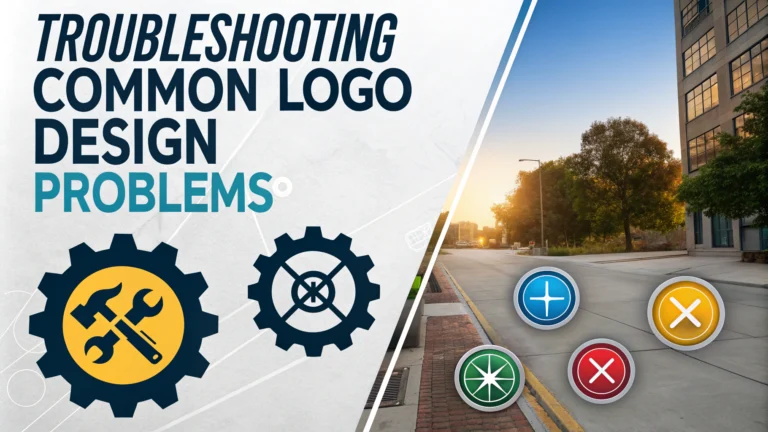A logo represents your brand’s identity, but creating the perfect design often comes with specific challenges that need smart solutions.
Common Logo Design Problems and Solutions
1. Overcomplicated Design
Simple logos work better because they’re easier to recognize and remember across different platforms and sizes.
- Remove unnecessary elements
- Limit color palette to 2-3 colors
- Focus on one distinctive feature
- Test at different sizes
2. Poor Scalability
Your logo must look good whether it’s on a billboard or business card.
- Design in vector format using Adobe Illustrator or similar tools
- Test logo at multiple sizes (16px to 500px minimum)
- Remove fine details that disappear when scaled down
3. Wrong Color Choices
Color psychology affects brand perception, and poor color choices can send the wrong message.
- Research color meanings in your target market
- Test logo in black and white first
- Ensure colors work in both digital (RGB) and print (CMYK)
4. Typography Issues
Text in logos needs to be legible and match your brand’s personality.
- Choose fonts that remain readable at small sizes
- Avoid trendy fonts that may look dated quickly
- Purchase proper font licenses for commercial use
- Test spacing between letters (kerning)
5. Generic Design
Standing out from competitors requires originality in your logo design.
- Research competitors’ logos
- Sketch multiple concepts before digitizing
- Create custom typography or modified existing fonts
- Add meaningful symbols specific to your brand
Technical Specifications
Follow these technical requirements for professional results:
| Format | Use Case |
|---|---|
| AI/EPS/SVG | Master files for scaling |
| PNG | Digital use with transparency |
| JPG | Standard web use |
Professional Help
Consider hiring a professional designer through platforms like:
- Behance (www.behance.net)
- Dribbble (dribbble.com)
- 99designs (99designs.com)
Testing your logo design with target audience members before finalizing can prevent many common issues and ensure your design resonates with intended viewers.
Additional Logo Design Considerations
6. Cultural Sensitivity
Logos must work across different cultures and markets without causing offense.
- Research cultural symbolism in target markets
- Check translations of brand name
- Avoid religious or controversial symbols
- Test with international focus groups
7. Digital Integration
Modern logos need to work seamlessly across digital platforms.
- Create social media variants
- Design responsive versions for different devices
- Ensure fast loading times
- Optimize for various background colors
8. Future-Proofing
Your logo should remain relevant for years to come.
- Avoid current design trends that may date quickly
- Create flexible versions for future brand extensions
- Document brand guidelines for consistent usage
- Plan for potential digital innovations
Conclusion
Successful logo design requires careful consideration of multiple factors, from technical specifications to cultural implications. By addressing common problems early in the design process and following established guidelines, you can create a lasting visual identity that effectively represents your brand across all platforms and markets.
- Prioritize simplicity and scalability
- Consider cultural and digital implications
- Test thoroughly before finalizing
- Document usage guidelines
- Invest in professional design when needed
FAQs
- What should I do if my logo appears pixelated when scaled?
Always design logos in vector format using software like Adobe Illustrator. Vector graphics remain crisp at any size, unlike raster images. Export to different formats only after the final vector design is approved. - How do I fix a logo that looks too cluttered?
Simplify the design by removing unnecessary elements, reducing the number of colors to 2-3, and ensuring there’s enough white space. Follow the principle that a logo should be recognizable even when scaled down to one inch. - What’s the solution for a logo that doesn’t work well in black and white?
Redesign focusing on shape and contrast rather than color. Test the logo in grayscale during the design process. Ensure the logo maintains its impact and readability when printed in monochrome. - How can I make my logo more versatile across different applications?
Create multiple versions of your logo: horizontal, vertical, icon-only, and with/without tagline. Ensure each version maintains brand consistency while being optimized for different contexts and sizes. - What should I do if my logo looks too similar to another company’s?
Conduct thorough research using trademark databases and image searches. Modify unique elements while maintaining your brand’s essence. Consider consulting with a legal professional about trademark issues. - How do I fix inconsistent typography in my logo?
Limit font choices to maximum two typefaces that complement each other. Ensure proper spacing between letters (kerning) and maintain consistent font weight throughout the design. - What’s the fix for a logo that doesn’t reflect the brand’s personality?
Review brand values and target audience. Adjust colors, typography, and symbols to align with brand personality. Test the logo with target audience members for feedback. - How do I resolve poor color contrast in my logo?
Use color wheel theory to select complementary colors. Ensure sufficient contrast between elements. Test the logo against light and dark backgrounds to verify visibility. - What should I do if my logo appears dated?
Modernize by simplifying complex elements, updating typography, and refining color choices. Avoid trendy elements that might quickly become outdated. Focus on timeless design principles. - How can I fix a logo that’s too complex for small-scale use?
Create a simplified version for small applications. Remove intricate details that don’t scale well. Consider developing a minimal icon version for favicon and small digital uses.








